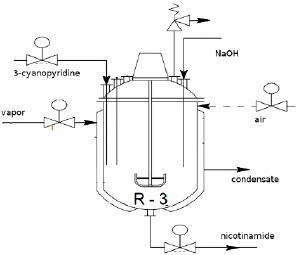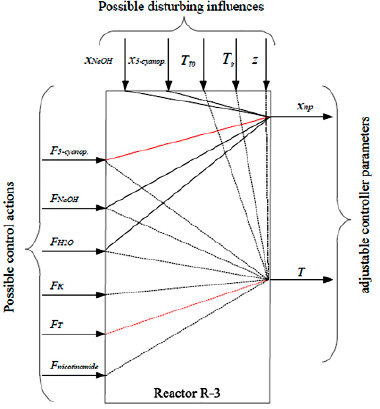The production of feed vitamin B3 is a newly designed production, which will be part of the Azot branch of JSC UCC Uralchem, Berezniki, Perm Territory.
The design capacity of the production of feed vitamin B3 (nicotinamide) for the finished product is 0.13 t/hour (1000 tons/year). The number of hours of work per year is 8016 [1].
Based on the features of the technological process, taking into account regulatory restrictions and the requirements of regulatory documents, an assessment was made of the main technical solutions for process automation. Based on the results of the analysis of the evaluation results, it was proposed to use computer technology and automation at the level of process control systems, since at this stage of production there are such automation functions as regulation, signaling and blocking. The implementation of the technological process without computers will require a large number of technological personnel. To automate the technological process, it is necessary to select not only the means of grass–roots automation, but also the controller by selecting input / output modules. The controller is located in the control panel. Data from the controller must be transmitted to the operator’s station, which will be responsible for monitoring all stages of production. At the operator’s station, information about the production process is output.
The aim of the study is to analyze the technological process for the production of nicotinamide as a control object in order to select a control system.
Process hydrolysis of 3–cyanopyridine in the presence of sodium hydroxide.The duration of the stage is 30 minutes.
By supplying nitrogen from a receiver with a temperature T = 18÷36°С and a pressure Р = 0.1 MPa at a maximum rate to the reactor with a stirrer pos. R–3 is supplied with a solution of 3–cyanopyridine. Further, with the help of squeezing with nitrogen from the receiver with temperature T = –52 ÷ +45 ° C and pressure P = 0.1 MPa, with a maximum speed into the reactor pos. R–3 is supplied with sodium hydroxide solution. The valves on the supply of raw materials are closed (to prevent reverse operation, since the release of gases begins from the reactor). The amount of sodium hydroxide is small compared to the amount of 3–cyanopyridine (in this case, it acts only as a catalyst that promotes the hydrolysis reaction of 3–cyanopyridine).
The reactor is heated through the jacket with steam at pressure P = 0.6 MPa and temperature T = 152 ÷ 165 °C to a temperature T = 100 ÷ –110 °C. Heating is done to initiate reactions. Two reactions take place in the reactor. The main one is the hydrolysis of 3–cyanopyridine to nicotinamide:

Secondary – the formation of sodium nicotinate with the release of ammonia:
 .
.
During the reaction, heat is released and the mixture is heated by about 10 ÷ 20 °C (maximum up to a temperature of T = 120 ÷ 130 °C). The released ammonia and evaporating water increase the pressure in the reactor pos. R–3.
The maximum allowable pressure is P = 0.5 MPa. The reactor is equipped with a line with gas phase withdrawal through a trap (expansion pipeline 740 mm long) – in case of an excessively violent hydrolysis reaction with the release of the main phase from the reactor (and subsequent discharge back).
The resulting nicotinamide and sodium nicotinate are dissolved in the mixture. Reactions are fast. The process can be considered completed within a few minutes.
After that, the valve for issuing the gas phase to the absorption unit is gradually opened to capture the released ammonia (until the pressure drops to atmospheric pressure within 20 minutes). The gas phase enters the heat exchange part, where it is condensed and cooled with the help of recycled water to a temperature of about 35 °C. Further, the gas passes through the nozzle part of the absorber, which is irrigated by a pump with a circulation solution of ammonia water with a temperature T = +30 ÷ +40 °C and a pressure P = 0.3 ÷ 0.6 MPa. Ammonia is absorbed by water with the release of heat. The purified gas phase is released into the atmosphere.
In the circulation circuit T–1–> V–2–> P–1–>C–1, the concentration of ammonia water is gradually accumulated. Upon reaching the ammonia concentration of at least 25% (monitored by the density meter), in the period between ammonia discharge cycles from pos. R–3, a solution of ammonia water is pumped out of pos. V–2 using a pump (about 1 time per day).
If the ammonia concentration starts to exceed 25% during the ammonia purge cycle from pos. R–3, water supply for irrigation is provided with a correction for the density of the solution. Pressure in the reactor system pos. R–3 is gradually reduced to atmospheric, and the temperature is down to ≈100 °C [1].
Analysis of the technological process as a control object. The production process of nicotinomide is continuous. Production is carried out in two shifts of 11.5 hours. In each shift, 2 cycles of preparation of nicotinamide are carried out. Cycle time ≈ 2 hours 50 minutes for shift 1, ≈ 3 hours 10 minutes for shift 2. The product is centrifuged and dried continuously for 11 hours shift.
The main apparatus in the technological scheme is a capacitive–type reactor with an R–3 stirrer. Therefore, we will consider it as an analyzed technological control object. In the reactor (Fig. 1), the reaction of hydrolysis of the initial substance of a solution of 3–cyanopyridine and a solution of sodium hydroxide into a solution of nicotinamide is carried out. The control object is multidimensional with distributed parameters. The purpose of the functioning of the object is to obtain nicotinamide with a given concentration [2–3].

Fig. 1. Flow chart R–3
Consider the R–3 reactor temperature control loop:
– possible control actions – coolant consumption FП, condensate consumption FК, consumption nicotinamide Fпр;
– possible controlled disturbing influences – initial temperatures of the coolant tТН0 and initial substances t0;
– possible uncontrollable disturbing influences – specific heat capacities of steam, initial substances.
The priority control action, to maintain the temperature at a given level, is the flow rate of the coolant through a control valve installed on the steam supply line to the reactor jacket.
Let us also analyze the control loop of nicotinamide concentration:
– controlled parameter – nicotinamide concentration;
– possible control actions – the consumption of 3–cyanopyridine, water, NaOH at the inlet to the reactor pos. R–3.
– possible controlled disturbances – composition 3–cyanopyridine and NaOH entering the reactor.
The priority control action, to maintain the concentration at a given level, is the flow of 3–cyanopyridine a control valve installed on the hydrochloric acid supply line to the reactor.
Results of the research and discussions
Analysis of the technological process as a control object showed that the process requires control and management of numerous parameters. In the production of nicotinamide, it is necessary to use computer technology and automation at the level of process control systems.

Fig. 2. Information scheme of the control object
The main purpose of using the process control system is to increase the reliability and safety of the process and its economic efficiency. The automation system in the production of nicotinamide should perform the following functions:
1. control functions – stabilization of technological parameters, ensuring a constant value specified by the regulations; implementation of blocking in case of emergencies and incorrect actions of operational personnel;
2. information functions: centralized collection and processing of information on the course of the technological process by reading it from measuring instruments and subsequent processing; providing the operator with information about the current values of technological parameters; warning and emergency light and sound alarms;
3. auxiliary functions: registration of the actions of operational personnel; archiving of received information.
To perform the listed functions of the process control system, the interaction of its following components is necessary: technical, software, information and organizational support, as well as operational personnel.
The technical support of the process control system is a set (complex) of technical means, which includes computing and control devices; means of obtaining (sensors), transformation, storage, display and registration of information; signal transmission devices and actuators [4-6].
For this process, at the field level of automation, it is necessary to select valves, sensors for level, temperature, pressure, composition. The unit is located in the production area in close proximity to the staff. The development of an automation system implies the integration of all parameters coming from the lower automation to the controller, located in the control cabinet and transmitting information for registration and display to the engineer’s station.
The use of a software logic controller will reduce the risk of systems failure in the absence of human control, as well as reduce human participation in the process itself [7].
The staff of the production site has a position of a process engineer who is able to conduct operational control of the operation of the installation during the technological process, as well as to carry out sampling in various parts of the system to recheck the quality and chemical composition of the product. The system constantly monitors and records data from the lower level of automation. The data is accumulated and stored on the organization’s server for 14 days. This measure allows you to analyze the operation of the installation in the absence of an engineer. Errors that occur in the operation of the installation are also stored on the server, but for 1 year. Data output and analysis is carried out from the engineer’s station.
The decisions made ensure that the technological process for obtaining nicotinamide is carried out in accordance with the regulations with a minimum participation of personnel with a high degree of safety and productivity.
Conclusion
In the above study, a set of measures was developed and technical solutions were proposed to create a system for automating the production of nicotinamide, which made it possible to bring the level of safety in line with regulatory requirements and improve the quality of automatic control of an existing technological facility.

